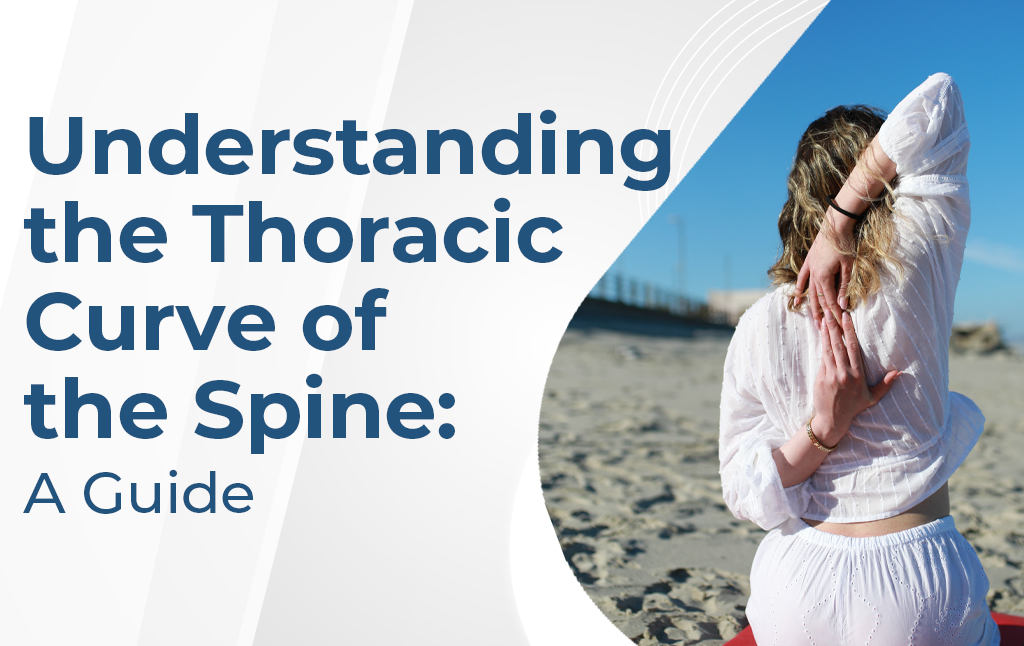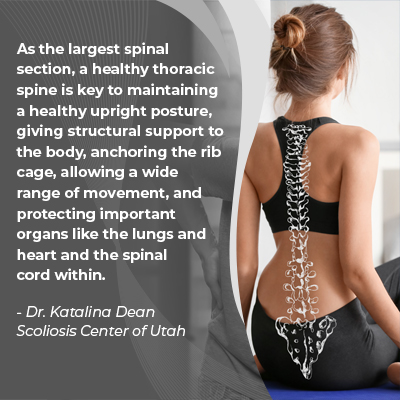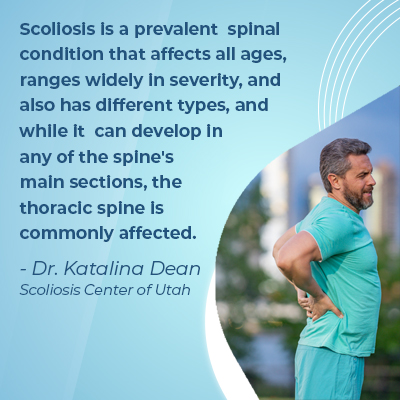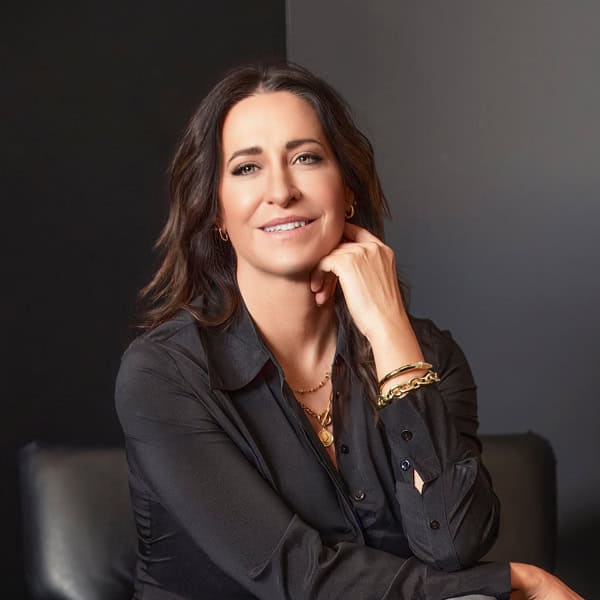Blogs
Understanding the Thoracic Curve of the Spine: A Guide

As one long structure, the health of the spine is shaped by the health of its individual sections. Containing 12 vertebral bodies, the thoracic spine is the largest spinal section so is vulnerable to a number of conditions such as kyphosis and scoliosis; both cause a loss of the thoracic spine’s healthy curve.
There are three main spinal sections, each with its own characteristics and roles to play in the spine’s biomechanics. The thoracic spine refers to the middle and upper back; it’s the largest spinal section and attaches to the rib cage. Its curve is important for posture, balance, flexibility, and movement.
The spine’s curves shape its overall health and function.
Spinal Sections
A healthy spine is key to overall health; it’s the body’s primary structural support, allows for a wide range of flexibility and movement, and protects the spinal cord.
The brain and spinal cord work together to form the central nervous system, so spinal health also facilitates communication between the brain, the spine, and the entire body.
The spine’s healthy curves and alignment are key to its overall health and function. A spine with its healthy curves in place is stronger, more flexible, and better able to handle mechanical stress than a spine with an unhealthy spinal curve.
As one long structure, if the health of a single spinal section is disrupted, its effects aren’t confined to that individual section; instead, it can disrupt the biomechanics of the entire spine, so let’s talk about the importance of the spine’s healthy thoracic curve.
A Healthy Thoracic Spine
The thoracic spine refers to the middle and upper back, and a healthy thoracic spine will have a healthy degree of kyphosis.
A kyphotic curve bends outward, and as the thoracic spine is the largest spinal section and is the only section that attaches to the rib cage, it has some unique responsibilities.
 As the largest spinal section, a healthy thoracic spine is key to maintaining a healthy upright posture, giving structural support to the body, anchoring the rib cage, allowing a wide range of movement, protecting important organs like the lungs and heart and the spinal cord within.
As the largest spinal section, a healthy thoracic spine is key to maintaining a healthy upright posture, giving structural support to the body, anchoring the rib cage, allowing a wide range of movement, protecting important organs like the lungs and heart and the spinal cord within.
There can be a healthy variance in thoracic curve sizes from person to person, but if a person’s thoracic kyphosis becomes excessive, a number of problems can occur.
A healthy degree of thoracic kyphosis would fall within a range of 20 to 40 degrees.
Thoracic Hyperkyphosis
The term kyphosis can refer to normal and excessive kyphosis and is also known as hyperkyphosis; it’s commonly diagnosed when the thoracic spine’s kyphosis is considered excessive at 50+ degrees and causes the middle/upper back to become noticeably rounded forward.
The condition is also known as roundback, referencing the postural changes it is associated with.
Hyperkyphosis indicates a loss of the thoracic spine’s healthy curve and needs to be addressed proactively.
There are different types of kyphosis with different treatment needs.
Postural Kyphosis
Postural kyphosis is the most common type and is most easily treated because it’s postural: caused by chronic poor posture.
When a condition is postural, a change in body position can alter the unhealthy spinal curvature, so this curve type is flexible, isn’t rigid and structural, and in most cases, can be corrected with lifestyle guidance and physical therapy.
Scheuermann’s Kyphosis
Scheuermann’s Kyphosis is more complex to treat because it’s a structural condition: it involves a structural abnormality within the spine itself.
When a spinal condition is structural, it involves the bones of the spine (their health and position), and an unhealthy spinal curve that’s structural won’t be altered by a mere change in body position or improvements to posture.
Structural spinal conditions have to be primarily impacted on a structural level with treatment.
Structural abnormalities that can cause the development of scheuermann’s kyphosis include vertebrae being more triangular in shape than rectangular; this can disrupt the spine’s ability to maintain its healthy curves, instead causing the spine to wedge forward with an exaggerated curve in the thoracic spine.
Scheuermann’s curves are rigid and harder to correct, and treatment options can include chiropractic care, physical therapy, bracing, rehabilitation, and/or surgical treatment.
Congenital Kyphosis
Babies are born with congenital kyphosis; it’s caused by the spine’s failure to form properly in utero.
In these cases, the vertebral bodies can be misshapen, or multiple vertebral bodies can fail to form into separate bones, instead becoming fused together and disrupting the spine’s ability to develop healthy curves.
Cases of congenital kyphosis often present with additional congenital abnormalities so patients need to be comprehensively assessed.
Congenital kyphosis typically worsens with growth and surgery can be recommended.
Symptoms of Thoracic Hyperkyphosis
If the thoracic spine loses its healthy degree of kyphosis, the thoracic spine’s ability to facilitate flexibility, movement, protect the spinal cord, important organs, and anchor the rib cage can be disrupted.
People with thoracic hyperkyphosis can develop a roundback appearance with the upper back and shoulders excessively rounding forward, a visible arch in the upper back, back pain of varying degrees, lethargy, increasing spinal rigidity, and tight hamstrings.
While a loss of the spine’s healthy thoracic kyphosis involves a loss of the thoracic spine’s healthy front-to-back curve, thoracic scoliosis can cause the development of an unnatural lateral curvature of the thoracic spine.
Thoracic Scoliosis
Scoliosis causes the development of an unnatural sideways curvature of the spine that also rotates, making it a 3-dimensional spinal condition.
 Scoliosis is a prevalent spinal condition that affects all ages, ranges widely in severity, and also has different types, and while it can develop in any of the spine’s main sections, the thoracic spine is commonly affected.
Scoliosis is a prevalent spinal condition that affects all ages, ranges widely in severity, and also has different types, and while it can develop in any of the spine’s main sections, the thoracic spine is commonly affected.
As the nature of scoliosis is progressive, the bend and rotation of the unnatural spinal curve can get worse over time, and as the largest spinal section, single scoliosis curves that develop in the thoracic spine are more prone to rapid progression.
As progression is triggered by growth, thoracic scoliosis that develops in adolescents is the most at risk for rapid progression due to significant growth spurts occurring.
If the thoracic spine develops scoliosis, the following symptoms are common:
- Postural changes (uneven shoulders, shoulder blades, uneven hips, the development of a rib cage arch)
- Disruptions to movement, balance, and gait
- Pain that can involve the muscles, the back, and/or nerve pain radiating into the extremities
As scoliosis doesn’t become a compressive spinal condition until skeletal maturity has been reached, thoracic scoliosis pain is more closely associated with adult scoliosis than childhood scoliosis.
Thoracic Scoliosis Treatment
Here at the Scoliosis Center of Utah, the treatment approach is conservative, individualized, and proactive.
The goal of conservative scoliosis treatment is to restore the spine’s balance and stability as this will improve the entire body’s balance and stability.
Thoracic scoliosis is addressed with the customization of a treatment plan combining the power of Chiropractic BioPhysics®, corrective bracing, and scoliosis-specific exercise programs that work together for 3D postural restoration.
Patients of the Center benefit from the application of what only 1 percent of the world’s chiropractors can offer: Chiropractic BioPhysics®.
Through a number of chiropractic techniques, the spine’s structural alignment may be improved, and when combined with the corrective power of bracing treatment and scoliosis-specific exercise, conservative treatment has fewer limits.
The ScoliBrace® is the world’s most advanced scoliosis brace; it has proven results with improving the spine and body’s position and alignment.
As the ScoliBrace® is designed to accommodate movement, when combined with a scoliosis-specific exercise program like ScoliBalance®, muscle strength and spinal flexibility can be improved for 3D correction.
ScoliBalance® also educates patients on how to hold their spine and body during movement and daily activities, largely through the use of mirror image exercises customized to address an individual’s body and curvature type.
While no treatment results can ever be guaranteed, when treatment is customized and includes the integration of CBP, ScoliBrace®, and ScoliBalance®, a healthy thoracic curve can be restored in many cases.
Conclusion
Understanding the importance of the spine’s healthy curves is essential for understanding overall spinal health and function.
The spine’s healthy curves make it stronger, more flexible, and better able to transmit nerve signals and handle stress.
Each spinal section has specific roles to play in how the spine functions, and the thoracic spine is the largest spinal section so is vulnerable to conditions that cause a loss of healthy spinal curves like kyphosis and scoliosis.
Kyphosis occurs if the thoracic spine’s outward-bending curve becomes excessive, causing the upper back and shoulders to become excessively rounded forward.
A diagnosis of thoracic scoliosis means an unnatural sideways-bending spinal curve that also rotates has developed in the thoracic spine.
If the thoracic spine loses its healthy curve and/or alignment, its ability to provide structural support, facilitate flexibility and movement, anchor the rib cage, and protect the spinal nerves within can be disrupted.
A spine that’s lost a healthy curve can cause a misaligned body with effects that are widespread, and as the largest spinal section, the health of the thoracic spine is key to overall spinal health.

Dr. Katalina Dean
Dr. Katalina Dean is the founder and clinical director of Scoliosis Center of Utah, in Midvale, UT. Her team specializes in posture correction, spinal rehabilitation, and non-invasive scoliosis care and bracing.
Call Today
Do You Qualify for Care?
Schedule an Appointment Below
